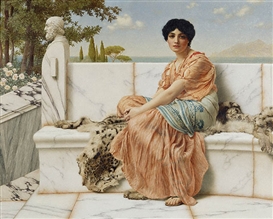Sweet Idleness: The Paintings of John William Godward
Born into a post Neo-classicism era, John William Godward claimed “The world is not big enough for myself and a Picasso"
Benjamin Blake Evemy / MutualArt
Jul 28, 2023
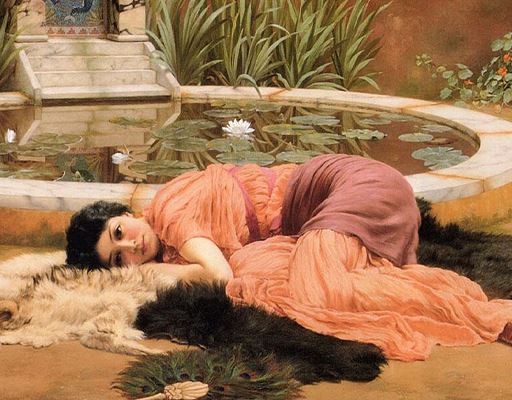
Scenes of beauty personified, the pale skin of dark-haired girls against even paler marble, perfectly proportioned figures sprawled upon oriental animal skins, wildflowers blossoming against the backdrop of the Mediterranean: John William Godward’s gorgeously rendered paintings epitomize the dreamlike essence of classical antiquity. But born at least a score too late to enjoy lifelong popularity, Godward’s depictions of the eternal feminine signal the dying sigh of Neo-classicism.
Dolce far Niente, 1904, oil on canvas, private collection
Even though an earlier version was painted in 1897 – and a later version in 1906 – 1904’s Dolce far Niente is often hailed as one of Godward’s most beautifully rendered paintings. Exuding an indisputable tranquility, its subject lies curled upon a makeshift bed of furs, peacock-feathered fan within arm’s reach, behind the still water of a pond strewn with lilies. The viewer is pulled into the intoxicating serenity of the piece by Godward’s masterful execution of the subject’s eyes, which stare out of the canvas as if lost in the throes of an opium-induced reverie. This effect is further strengthened by the positioning of the subject in the lower half of the canvas, which serves to pull the viewer down to ground level as well. This famed 1904 version was purchased in 1995 for the private collection of Andrew Lloyd Webber.
Born in August 1861 in Wimbledon, London, John William Godward was the eldest of five children. His family was relatively wealthy, and he was subject to a strict upbringing. The young Godward showed a natural talent for art, but his overbearing parents were firmly against it. This harsh family environment has been speculated to be a significant factor behind the artist’s shyness and reclusiveness in adulthood, and may likely be the reason why he so aptly created scenes of such hypnagogic beauty, for he possessed the need to truly escape into a world that was not of his own reality. So strong was his passion for the arts that Godward became a protégé of Sir Lawrence Alma-Tadema without the consent of his father, subsequently exhibiting pieces at the Royal Academy which garnered positive public reception.
The Quiet Pet, 1906, oil on canvas, private collection
The Grand Tour was the genesis of Britian’s obsession with the classical history and culture of Europe and resulted in great stylistic shifts in the world of art and architecture. The 18th century saw this neo-classical influence bloom with the rise in numbers embarking on the Grand Tour. Seen as part of their education, and organized by their parents, the young men who ventured out on these tours of the continent often came back armed with new ideas in regard to art, as well as actual pieces purchased during their time abroad to display in their homes. In fact, the influence that the classical world had on these young men was at times so profound that they altered their stately houses and gardens to closer reflect what they saw abroad and went so far as to form societies for those who had spent time in particular regions, such as the Society of Dilettanti, for those who had returned from Italy. As a subsequence of this, the Neo-classical art movement was born.
A Pompeii Bath, 1890, oil on canvas, private collection
Godward was brought forth into this world a little too late to embark upon the Grand Tour of lore. Although the artist would spend time in Italy in 1905, in what is really the modern equivalent of the Grand Tour, visiting various islands in the south, as well as Pompeii – which, not surprisingly, was already a significant source of inspiration for his paintings. Interestingly, many of his pieces depicting subjects in standing poses are highly reminiscent of classical statues, as can be seen his striking 1890 piece, A Pompeii Bath.
Godward’s second trip to Italy was a little less conventional. Even though the artist’s family was never fond of his artistic ambitions, absconding to Rome with one of his models in 1912 was the breaking point. They cut off all contact with him, and even went so far as to remove his likeness from all family pictures. Even though his love for his Italian-born Italian model was likely not reciprocated, Godward would stay in the country for around a decade, returning to England in 1921. Suffering from insomnia and depression, he would commit suicide the following year.
Summer Flowers, 1903, oil on canvas, unknown collection
Even though Neo-classicism had a more than impressive run in England, its popularity was starting to significantly dwindle by the end of the 19th century, and by the onset of the 20th century it was all but over, with the modern art movement gaining significant traction. Godward was all too aware of this, realizing that his scenes of such timeless beauty were not so timeless after all. On December13, 1922, at the age of sixty-one, he took his own life by putting his head in the oven at his Fulham studio. In his suicide note, he reportedly wrote that “The world is not big enough for myself and a Picasso.”
In the Tepidarium, 1913, oil on canvas, unknown collection
Even in death, John William Godward could not escape the disapproval of his family. Deeply ashamed, they burned all of his remaining papers. Only one photograph of the artist is known to have survived. His body was laid to rest in Brompton Cemetery, in West London. What is truly tragic is that unlike many artists whose lives end by their own hand or under similarly dramatic circumstances, such as severe illness or perishing in abject poverty while trying desperately to make a living from their art, John William Godward’s work did not gain popularity post-death. His stunning scenes of classical beauty are often regarded as too similar to the works of other Neo-classicists, such those of Sir Lawrence Alma-Tadema, which is truly a pity as Godward’s execution of his subjects is highly refined, and many of his pieces stand as some of the most breathtaking examples of the movement. Perhaps a large part of this is because so little documentation on the artist survived, or more sadly, he likely was just born too late for even his untimely death to make a stir in the art world.
For more on auctions, exhibitions, and current trends, visit our Magazine Page


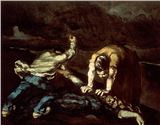
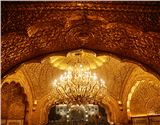


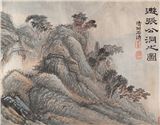
.Jpeg)
.Jpeg)
.Jpeg)
.Jpeg)
.Jpeg)
